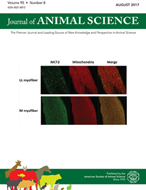-
Views
-
Cite
Cite
G Bee, S Gebert, R Messikommer, Effect of dietary energy supply and fat source on the fatty acid pattern of adipose and lean tissues and lipogenesis in the pig, Journal of Animal Science, Volume 80, Issue 6, June 2002, Pages 1564–1574, https://doi.org/10.2527/2002.8061564x
Close - Share Icon Share
Abstract
Forty Large White barrows were used to determine whether the effects of dietary fat source (tallow or soy oil at 5% of the diet) on lipogenesis and fatty acid profile of porcine adipose and lean tissue were dependent on dietary digestible energy density (8.8 vs 14.0 MJ DE/kg). Barrows were allocated to one of four groups and offered a fixed amount of feed (170 g x BW0.569/d) from 27 to 105 kg BW. The fatty acid composition of the backfat layers (BF), omental fat (OF), and i.m. adipose tissue of longissimus muscle as well as the activity of lipogenic enzymes of the adipose tissues were determined. Growth performance and carcass characteristics were affected by the dietary energy level (P < 0.01) but not by fat source. In accordance with the lower carcass fat deposition, the activity of lipogenic enzymes were decreased in the low-energy groups (P < 0.01). Within dietary energy level, inclusion of soy oil resulted in increased proportion of PUFA that was compensated by decreased saturated (SFA) and monounsaturated fatty acid (MUFA) proportions (P < 0.01). The SFA changes accounted for 23 (BF) and 24% (OF) of the PUFA changes in the high-energy and 31 (BF) and 39% (OF) in the low-energy diets. The differences in the fatty acid proportions between the soy oil and tallow group were more pronounced in the low-energy groups (fat source x energy density interactions: P < 0.01). Pigs fed the soy oil, low-energy diet had decreased SFA (BF: 28%; OF: 30%) and MUFA (BF: 13%; OF: 19%) concentration, whereas PUFA concentration was increased (BF: 59%; OF: 88%) compared with pigs fed the soy oil, high-energy diet. However, in the tallow groups, pigs fed the low-energy diets had slightly decreased SFA (BF: 14%; OF: 12%) and relatively constant MUFA (BF: 3%; OF: 1%), whereas PUFA concentration increased (BF: 39%; OF: 62%) relative to pigs fed the tallow high-energy diet. Lipid content of the i.m. adipose tissue was decreased in the low-energy groups (P < 0.05). Contrary to what was observed in the adipose tissues, increased PUFA concentration in the neutral and polar lipid fractions of the longissimus muscle was predominantly compensated by reduced MUFA deposition. In the polar lipid fraction, the proportions of both SFA and MUFA were decreased by the low-energy diet. Thus, the extent to which tissue concentration of fatty acids are altered from dietary fats differing in the degree of unsaturation depends on the dietary energy level.





